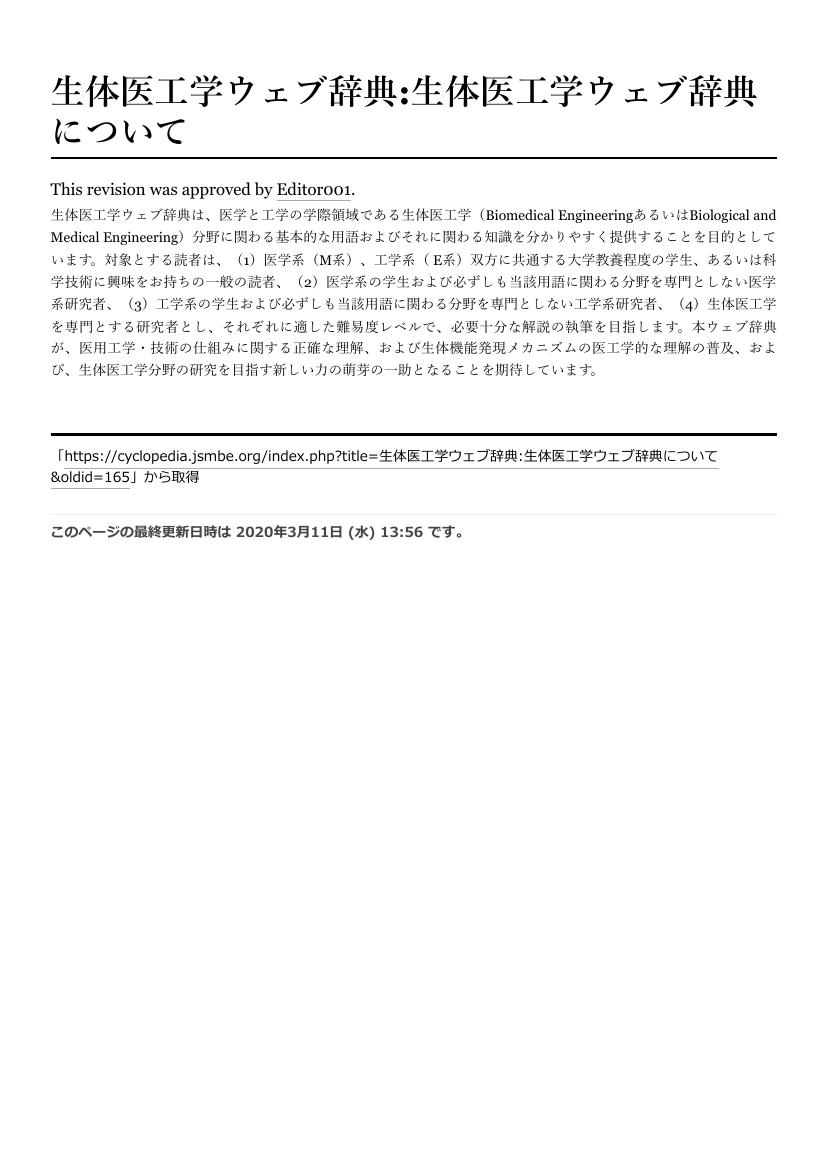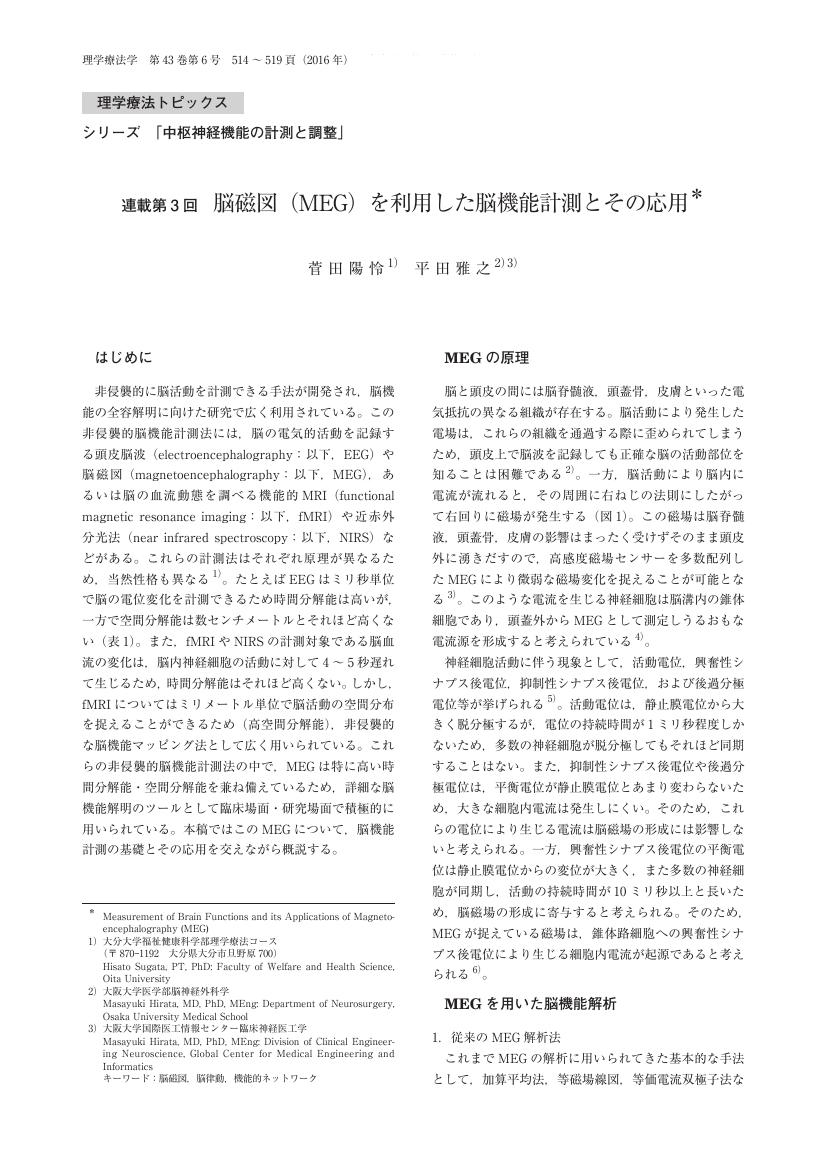11 0 0 0 OA ブレイン・マシン・インターフェイス (BMI) が切り開く新しいニューロテクノロジー
- 著者
- 吉峰 俊樹 平田 雅之 栁沢 琢史 貴島 晴彦
- 出版者
- 日本脳神経外科コングレス
- 雑誌
- 脳神経外科ジャーナル (ISSN:0917950X)
- 巻号頁・発行日
- vol.25, no.12, pp.964-972, 2016 (Released:2016-12-25)
- 参考文献数
- 21
- 被引用文献数
- 1
Brain-machine interface (BMI) とは 「脳と機械の間で信号をやり取りする」 技術であり, 失われた神経機能の代行や補完を目的としている. この10年あまりの間に急速に進歩しつつあり, すでに実用化されたものもある. 大阪大学では 「ヒトが考えただけでコンピュータやロボットを操作できる」 技術を開発中である. BMI技術は神経科学のほか情報科学や多方面の工学領域と統合されて実用化される学際的融合技術であるが, 今後, 人工知能 (AI) 領域の研究の進歩も加わり, ますます広い領域において革新的な展開が期待される新しいニューロテクノロジーである.
5 0 0 0 OA 体内埋込型ブレイン・マシン・インターフェース
- 著者
- 平田 雅之
- 出版者
- 日本神経治療学会
- 雑誌
- 神経治療学 (ISSN:09168443)
- 巻号頁・発行日
- vol.33, no.3, pp.399-404, 2016 (Released:2016-11-10)
- 参考文献数
- 19
Research and development of brain-machine interfaces (BMIs) are now ongoing to support severely disabled people due to intractable neurological disease, spinal cord injury and stroke etc. Implantable brain-machine interfaces using intracranial electrodes require surgical intervention. However, it may achieve higher performance. Here I describe the trends of domestic and international BMI research for clinical application.In USA, clinical research of BMIs using micro–needle electrode array are ongoing in University of Pittsburgh and in Brown University. They reported that three dimensional real time control of a robotic arm and writing using a mouse cursor were successfully performed by severely disabled people. We demonstrated that, real time control of a robotic arm was successfully performed by patients with intractable epilepsy or intractable pain whom intracranial electrodes were temporarily implanted. And most recently we demonstrated that a severely disabled patient with ALS successfully controlled a robotic arm and writing.A fully implantable device is another key to clinical application for implantable BMIs. Development of 40 to 100 channel implantable devices are ongoing in USA, France and Germany. However clinical application of these implantable devices has not been reported yet. We developed a 128–ch electrocorticographic fully implantable device using a contour fitting 3D cortical electrodes and completed chronic implantation in monkey for 6 months. Translational research with companies is indispensable for clinical application. We have to establish a business model and perform strategic pharmaceutical affairs based on it.From technological point of view, implantable BMIs will be clinically applied in the next 5 to 10 years. Now it's time to think well about its application.
2 0 0 0 OA 生体医工学ウェブ辞典(第一分冊)
- 著者
- 相川 慎也 芦原 貴司 天野 晃 有末 伊織 安藤 譲二 伊井 仁志 出江 紳一 伊東 保志 稲田 慎 井上 雅仁 今井 健 岩下 篤司 上村 和紀 内野 詠一郎 宇野 友貴 江村 拓人 大内田 研宙 大城 理 太田 淳 太田 岳 大谷 智仁 大家 渓 岡 崇史 岡崎 哲三 岡本 和也 岡山 慶太 小倉 正恒 小山 大介 海住 太郎 片山 統裕 勝田 稔三 加藤 雄樹 加納 慎一郎 鎌倉 令 亀田 成司 河添 悦昌 河野 喬仁 紀ノ定 保臣 木村 映善 木村 真之 粂 直人 藏富 壮留 黒田 知宏 小島 諒介 小西 有人 此内 緑 小林 哲生 坂田 泰史 朔 啓太 篠原 一彦 白記 達也 代田 悠一郎 杉山 治 鈴木 隆文 鈴木 英夫 外海 洋平 高橋 宏和 田代 洋行 田村 寛 寺澤 靖雄 飛松 省三 戸伏 倫之 中沢 一雄 中村 大輔 西川 拓也 西本 伸志 野村 泰伸 羽山 陽介 原口 亮 日比野 浩 平木 秀輔 平野 諒司 深山 理 稲岡 秀検 堀江 亮太 松村 泰志 松本 繁巳 溝手 勇 向井 正和 牟田口 淳 門司 恵介 百瀬 桂子 八木 哲也 柳原 一照 山口 陽平 山田 直生 山本 希美子 湯本 真人 横田 慎一郎 吉原 博幸 江藤 正俊 大城 理 岡山 慶太 川田 徹 紀ノ岡 正博 黒田 知宏 坂田 泰史 杉町 勝 中沢 一雄 中島 一樹 成瀬 恵治 橋爪 誠 原口 亮 平田 雅之 福岡 豊 不二門 尚 村田 正治 守本 祐司 横澤 宏一 吉田 正樹 和田 成生
- 出版者
- 公益社団法人 日本生体医工学会
- 雑誌
- 生体医工学 (ISSN:1347443X)
- 巻号頁・発行日
- vol.Dictionary.1, pp.1-603, 2022 (Released:2022-03-31)
2 0 0 0 OA 脳磁図(MEG)を利用した脳機能計測とその応用
1 0 0 0 脳信号解読技術を用いた言語機能再建の試み
(1)MEG、皮質脳波(ECoG)を用いた脳律動計測ECoGとMEGとで同一課題施行し、解析ソフトBESAを用いて時間周波数解析、coherence解析を行った。詳細な脳内処理過程が明らかになるとともに、言語領野に共通の律動帯域と特有の律動帯域があることが明らかなり、現在論文投稿準備中である。(2)脳磁図(MEG)での言語優位半球の評価、言語機能局在の評価単語黙読課題を用いた場合、アミタールテストとの比較で85%一致、電気刺激によるマッピング法との位置の差は6.3±7.1mmであり、非侵襲的検査法として優れた方法であると証明された。アミタールテスト、脳表電気刺激の結果と比較し、成果を論文に投稿した。(3)脳信号解読まず、言語機能解読の基礎となる運動機能についてもsupport vector machineを用いて運動内容解読を試みた。運動内容推定については3種の運動内容弁別が80-90%の正答率でリアルタイムに弁別できることが明らかとなり、英文誌Neuroimageに発表した。言語に関しても時の皮質脳波を計測し、support vector machineを用いた脳信号複号化により発語内容推定を行った。カテゴリー別語想起課題にたいするカテゴリー識別は有意差のある結果が得られなかった。ピ、ポ、ギ、ゴなど単純な発語課題の識別率は運動内容解読には及ばないものの、本方法で言語内容解読がリアルタイムに可能なことが明らかになった。今後さらに性能向上のために計測・解析方法に工夫が必要であると考えられた。
1 0 0 0 OA 特集「BMI/BCIの応用に向けて」
- 著者
- 平田 雅之
- 出版者
- 一般社団法人 日本臨床神経生理学会
- 雑誌
- 臨床神経生理学 (ISSN:13457101)
- 巻号頁・発行日
- vol.46, no.1, pp.33, 2018-02-01 (Released:2018-03-13)
- 著者
- 平田 雅之
- 出版者
- 未来医学研究会
- 雑誌
- 未来医学 (ISSN:09109870)
- 巻号頁・発行日
- no.30, pp.50-58, 2017-03-15
1 0 0 0 OA 人のような存在感を持つ半自律遠隔操作型アンドロイドの研究
- 著者
- 石黒 浩 平田 勝弘 小川 浩平 開 一夫 石井 カルロス寿憲 吉川 雄一郎 岩井 儀雄 西尾 修一 中村 泰 吉峰 俊樹 平田 オリザ 神田 崇行 宮下 敬宏 板倉 昭二 港 隆史 平田 雅之
- 出版者
- 大阪大学
- 雑誌
- 基盤研究(S)
- 巻号頁・発行日
- 2013-05-31
本研究は,従来の遠隔操作型アンドロイドやロボットを,さらに進化させ,今後主流になると予測される遠隔操作型ロボットの研究開発プラットフォームとして,半自律遠隔操作型アンドロイドやロボットの実現を目指した研究開発を展開した.具体的には次の課題について研究に取り組んだ.多様な相互作用が可能な半自律アンドロイドの開発.社会的存在としてのアンドロイドやロボットの機能開発.現実社会おけるアンドロイドやロボットの社会における実証実験.アンドロイドのブレインマシンインターフェース(BMI)による遠隔制御の研究.
- 著者
- 平田 雅之 柳澤 琢史 松下 光次郎 Shayne Morris 神谷 之康 鈴木 隆文 吉田 毅 佐藤 文博 齋藤 洋一 貴島 晴彦 後藤 哲 影山 悠 川人 光男 吉峰 俊樹
- 出版者
- 日本脳神経外科コングレス
- 雑誌
- 脳神経外科ジャーナル (ISSN:0917950X)
- 巻号頁・発行日
- vol.21, no.7, pp.541-549, 2012-07-20
ブレイン・マシン・インターフェース(BMI)は脳信号から運動意図・内容を読み取って外部機器を制御する技術である.われわれは脳表電極を用いたBMIにより,筋萎縮性側索硬化症等の重症身体障害者に対する機能再建を目指して研究開発を行っている.これまでにγ帯域活動を用いた連続的な解読制御手法により,ロボットアームのリアルタイム制御システムを開発し,脳表電極留置患者による物体の把握・把握解除に成功した.感染リスク回避のためにはワイヤレス体内埋込化が必須であり,ワイヤレス埋込装置のプロトタイプを開発した.今後は,重症の筋萎縮性側索硬化症を対象として,有線・ワイヤレス埋込の2段階での臨床試験を経て実用化を目指す.



